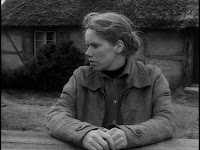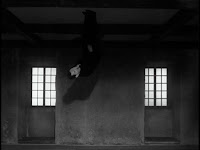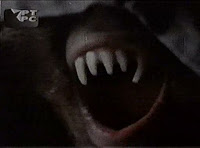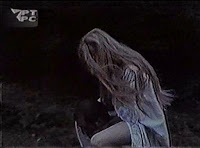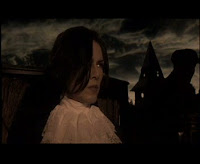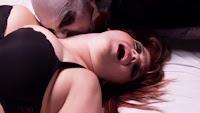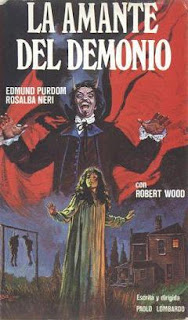Saturday, July 31, 2010
Vamp or Not? Hour of the Wolf
I do a variety of searches round the net looking for obscure vampire titles and this came up in one such search. I found a couple of articles that mentioned vampires and vampiric ghosts in connection with this and one lone comment on IMDb struck me as a commentator, MisterWhiplash, headed his comment “A Bergman vampire movie, but without any vampires- pure, Gothic chills”.
I decided, therefore, to explore the film – which had the working title (as it was written) of The Cannibals.
The film begins with a legend that explains that some years ago the painter Johan Borg (Max Von Sydow) vanished without a trace whilst on the Frisian Island of Baltrum. His wife Alma (Liv Ullman, Leonor) gave *me* (presumably Bergman or an unnamed fictional director, during the opening we can hear the sounds of a movie sound stage being worked upon until the director calls all to order and the film begins) his diary and between that and interviews with Alma the film was born. We see her emerge from a cottage on the island – she seems reluctant to talk further to the camera but eventually mentions the fact that she is now eight months pregnant and then begins to explain how she and Johan arrived there that year.
We see them arrive and Johan push their things up to the cottage on a wheelbarrow. They go to the island each year so that he can paint and escape people. We do not see, but hear from Alma that when they arrived they found footprints in the flowerbed beneath the kitchen. At first things seem idyllic, despite this. Johan sketches Alma and they seem a happy couple. This façade cracks quickly and we see quickly that Johan is a tortured artist.
It is night and Alma is clearly uncomfortable as Johan paces. He suddenly pulls out a sketchbook and tells her that he has sketched *them*. When Johan’s art is referred to we never see the art ourselves. He explains that the first one is common and harmless, he thinks he is homosexual. The next is an old lady, always threatening to remove her hat and then her face. The worst of them all is the birdman, Johan doesn’t know if the beak is real or a mask but he is Papageno (the character from the Magic Flute who represents error, the Magic Flute is referenced again later and Bergman famously directed a filmic version of the opera). What are these things (he lists more of them)? Personal demons, actual demons, ghosts? Johan cannot sleep, he feels, until it is light but then falls asleep and is helped to bed.
The next day, as Johan goes to paint, Alma is doing housework when a woman appears at the cottage – she is the Old Lady with Hat (Naima Wifstrand), as Johan described, and Alma can see and converse with her. She tells Alma that she is 216 years old and then corrects that to 76. She then tells Alma that under the bed is a black satchel containing the sketches that Johan made of her and the others – she must not let him destroy them – and his diary. She advices Alma to read it and she does.
The first entry, it appears, tells of Johan, having recently been ill, being approached by Baron von Merkens (Erland Josephson) – the owner of the island – who invites him to dinner at the castle. The next entry tells of meeting his previous lover Veronica Volger (Ingrid Thulin). She tells him he must be more careful as her breast is bruised and then she reveals that she has received a letter that warns her – of what is unclear but we assume her affair with Johan. We see Johan pace towards the cottage and a man follows with laboured breaths. He identifies himself as the Therapist Heerbrand (Ulf Johansson) and he so annoys Johan that he punches the man. When he gets to the cottage he and Alma settle down to eat (she quickly hides his diary) and she mentions that she needs money. He places notes on the table but she wants to detail the household accounts – something he seems uninterested in. When he tells her they have been invited to the castle she already knows – there seems to be a non-linear aspect to the diary entries because of this.
At the castle they are introduced to Corinne (Gertrud Fridh) wife of the Baron, the Countess (Gudrun Brost) the Baron’s mother, Ernst (Bertil Anderberg) the Baron’s brother, Heerbrand and an archivist named Lindhorst (Georg Rydeberg). It is astounding how much Rydeberg looks like Bela Lugosi – but that a vampire does not make! It is entirely possible that these people are part of Johan and Alma’s psychosis (as they now seem to share a psychosis) or something else. The dinner party is oppressive, the use of sound astounding making the viewer tense – picked out in conversation is the line “We still have our fangs.” The Baron and Corinne claim to know Veronica – they have the portrait of her that Johan painted and later the Baron suggests she is his mistress. Alma is aware that they were together for five years and later we find out that their tempestuous relationship was not only a scandalous affair but had elements tantamount to stalking and Johan ended up hospitalised (presumably in a psychiatric hospital).
After the dinner there is a puppet show and the tiny puppet (Folke Sundquist) actually appears to be alive, singing the Tamino part of the magic Flute, an extract from Act 1 scene 2 where Tamino sings of eternal night. Alma and Johan are becoming fraught. If we look to his previous passionate affair, and then note that Alma believes he rarely even kisses her we wonder at their relationship. We hear that Alma believes that they – the castle denizens – want to control him. I could continue waxing lyrical about this astonishing film but I want to concentrate on three parts that are relevant to the “Vamp or Not?”
In the Hour of the Wolf – a specific hour in the night – Johan tells Alma of the abusive punishment he suffered as a child and then confesses the truth regarding the day he claimed to suffer a snakebite. We see him on the rocks, fishing and painting and a young boy (Mikael Rundquist) in trunks suns himself, messes with his gear and seems almost flirtatious. The music becomes unbearable to us and Johan's frustrations grow. He says something inaudible and then attacks the boy, who tries to bite his neck and is crushed against a wall. On the floor he bites Johan's ankle. (Why would the bite even resemble a snakes? Surely the dentition would be human?) Johan bludgeons him and throws the body into the water. The sight of him seems to have been lifted, years later, by Ken Russell in the film Gothic.
Later, in the castle as the world turns upside down, we see many a sight. We see the Baron walking up a wall and hanging from the ceiling, we see the Old lady with Hat actually peel her face away and remove her eyes. It seems that Johan might already be amongst the dead as his colour is described as pallid and his lips blue before Lindhorst puts makeup on him and makes him wear a dressing gown before being shown to Veronica. Lindhorst reveals wings during this – is he the birdman?
When he finds Veronica – led out on a table and covered with a sheet as though she were a body in a morgue – Johan kisses her. When he looks up the smeared lipstick does look like blood and his eyes seem sunk into his skull. The various members of the household watch him mockingly, laughing at the spectacle he has become. He runs from the castle into the wilds.
His death is sudden and Alma (whom he thinks he has fatally shot) sees it. The household attack him, firstly the therapist strikes him and then the Countess slits his throat at the artery. Lindhorst at once man and bird pecks/strikes his temple. Then they fade into the background and Alma sees that no-one, including Johan, is there. He likely died but he truly vanished. Is it Vamp?
I’d love to say yes. This is an astonishing film, with wonderful cinematography as one would expect. It is a revelation, a many layered spectacle for those with the desire to delve into its mysteries and things do remain mysterious. However, despite some elements it is NOT VAMP. I watched it looking for those elements and so they seemed more obvious (perhaps I looked at them as potentially vampire related because I wanted it to be so). All in all, I do not know what the household etc were but, being honest with myself, there is nothing that makes them particularly vampiric in essence. They are his personal demons made flesh, perhaps, or even they are Alma’s – as is Johan. However, you could do a lot worst than settle down to watch this multi-layered masterpiece. The imdb page is here.
Posted by
Taliesin_ttlg
at
2:18 AM
4
comments
![]()
Labels: Not Vamp
Thursday, July 29, 2010
Leptirica – review
Release date: 1973
Contains spoilers
Leptirica (the she-butterfly) is another one of the great sins of vampire cinema, in that it is begging for a fully restored DVD release – possibly as a double set with Kadijevic’s 1990 reworking of Viy, Sveto Mesto.
This film is fascinating because of the very pure Slavic lore the film taps into. It is based on the story “Posle Devedeset Godina” or “90 Years Later” by Milovan Glišić. The story features a folkloric vampire who goes by the name Sava Savanović. The film is so rich in lore that I will, with genuine glee, spoil the story completely.
It begins with a man, Zivan (Slobodan Perovic) leading his horse to a mill. He calls for the miller, Vule (Toma Kuruzovic), and when he gets no response he carries his grain in. Vule has been napping, lulled to sleep by the sound of the mill. There are the uncanny cries of an owl, which Vule shoos to, and Zivan asks whether the miller sleeps there at night, he does, and whether he is afraid. Outside the mill we see Radojka (Mirjana Nikolic) on a hillside, identified by Vule as Zivan’s daughter and, as he puts it, as pretty as a butterfly.
He enters the mill again and, after a while, the eerie owl calls begin again. He exclaims ‘drop dead’ before falling asleep. We see the mill stop. A pair of eyes appear, monstrous, looking in at Vule through the boards of the wall and then we see a dark, hirsute and clawed hand touch the flour – poetically contrasting the white and black. A hooded creature is seen, its teeth sharp are monstrous and it bites at Vule’s neck. When it leaves the mill restarts but Vule is dead.
He is found the next day by one of the villagers and we discover that he is the third or fourth miller killed in the last year. Vampires are mentioned as is the word vukodlak – a particular Slavic name for a vampire, indeed Sava Savanović himself is mentioned; but all of these are dismissed as silly folklore. Meanwhile a young man, Strahinja (Petar Bozovic), has gone to Radojka. It is clear that they are in love but she says that Zivan has invited suitors for her hand. When Zevan appears she tells Strahinja to run and is subsequently told off by Zevan for being where she is.
Strahinja asks Zevan for Radojka’s hand in marriage but is given short shrift as he is poor. He decides he will leave the area as he cannot stand watching her marry another. However the men of the village see him and suggest he becomes the new miller, something he agrees to. Again, on his first night in the mill, the mill stops and again the eyes look into the mill. Strahinja falls, pulling bags of flour with him, and somehow – through luck and clumsiness, it seems – manages to survive the night, though at first the men fear the white apparition (he is covered in flour) they see.
The men decide to find the grave of Sava Savanović. They question an old woman, Mirjanicka, and eventually get an idea of where the alleged vampire’s grave should be. The search seems futile until one of the men decides to get hold of Zivan’s stallion. We have come across using a horse to find the grave of a vampire before and at this point I would like to start referencing the book The Vampire: A Casebook edited by Alan Dundes – for the sake of this review I have used the edition on Google Books. In the chapter “In Defence of Vampires” by John V A Fine Jr we find a quote by Vuk Karadžić, “they take a black stallion without any spots or marks to the graveyard and lead it among the graves where it is suspected there are vukodlaks, for they say that such a stallion does not dare to step over a vukodlak.”.
Whilst they are getting the stallion we see Radojka in the woods, she listens to the sound of the owls and it seems that there is almost a sexual tension in the air. Meanwhile the men have found the grave and start to dig until they find a coffin and they hammer a stake through the unopened lid as the priest prays. This, again, has a folkloric root but, of course, one we are more familiar with. However more interesting is the appearance of a butterfly from the coffin (through the hole in the lid). The men try to catch it but fail. Returning to The Vampire: A Casebook and South Slavic Countermeasures against Vampires by Friedrich S Krauss we read, “the others present watch for the appearance of a moth (or butterfly) flying away from the grave. If one does fly out of the grave, everyone runs after it in order to capture it. If it is caught, it is thrown onto a bonfire so that it will die. Only then is the vampire completely destroyed. If the butterfly escapes, however, then, alas, woe to the village…”
The men obviously haven’t read Krauss and are somewhat happier in disposition then they should be. They are quite taken with Strahinja and suggest that he should simply take Radojka as his wife – something the priest concurs with. Someone also, interestingly, suggests that Zivan is not her father but an uncle, maybe. They go get her and an angry Zivan watches from a distance. He catches the butterfly and vows vengeance. Tradition states that Radojka must stay in a house guarded by a woman for one night but Strahinja tells her that he will go to her.
He sneaks into the house and is undressing her when he discovers that she has a gaping wound in her abdomen – perhaps as though a stake had pierced her stomach. She starts to transform before him, becoming fanged and then hirsute. You should remember that there is little difference, traditionally, between the werewolf and the vampire and thus her appearance is not so unusual.
She leaps on his back, but she is not attacking him – not at this point. She grabs his mouth and, if we look forward in time to Kadijevic’s Sveto Mesto, the actions are identical to the hag coming to Toma. She is hag-riding him and she directs him straight to the grave. When she lets go she continues to push him forwards, towards the grave. Strahinja starts to pull at the stake that still protrudes from the coffin and Radojka reacts as though the stake is being pulled from her. He retrieves the stake and she falls, all we see is her white nightdress and the coffin opens. In a moment of duality the vukodlak Radojka emerges from the coffin, in black, she turns and runs at Strahinja who lifts the stake before him.
The film ends in the morning with Strahinja led motionless in the meadow and the butterfly sat upon his temple. So the film has ended, but what a film. It packs in such a lot of traditional Slavic lore that for the dedicated fan of the genre it is a must see film. I liked the use of the butterfly, which was much more dignified than the use of moths in the Blood Beast Terror. We should remember that Stoker himself mentioned a vampiric affinity with moths in Dracula when he suggested “he can command all the meaner things, the rat, and the owl, and the bat, the moth, and the fox, and the wolf”. In this however, I think the butterfly was representative of the vampire’s soul or spirit.
The film is creepy and rather atmospheric, the mill being a great location. This fits in with tradition. Returning to the Vuk Karadžić quote, he tells us that, “in times of hunger vampires often gather near mills and around granaries.” It seems a little dreamlike in places though I suspect that the film showed its hand too early with the attack on Vule being so explicit – the argument that it wasn’t something supernatural, that the men have, seems half-hearted at best at that point, especially as they take little convincing to use traditional detection methods thereafter.
That aside an important film begging for a full re-mastered international release. 7.5 out of 10. The imdb page is here.
Posted by
Taliesin_ttlg
at
8:24 AM
14
comments
![]()
Labels: butterfly, Sava Savanović, vampire, vukodlak
Wednesday, July 28, 2010
Join Team Blade
A welcome to the new Indy Mogul web-show: Rated Awesome. Funny, funny stuff...
Posted by
Taliesin_ttlg
at
11:57 AM
9
comments
![]()
Tuesday, July 27, 2010
Sveto Mesto – review
Release Date: 1990
Contains spoilers
Sveto Mesto or a Holy Place is a flick I’ve had for a while but it was friend of the blog House of Karnstein who recently let me know that subtitles had appeared for the film. It is based on Gogol’s short story Viy and owes much, in some respects, to the wonderful 1967 film Viy.
For those who don’t know, the story had a definitive edge of vampirism to it. The films concentrate more on the witch aspects of the story. However we get psychic vampirism and what we see is the strigoï vii (or living witch/vampire) who becomes the strigoï mort (undead vampire) on death. I did a ‘Vamp or Not?’ on the 1967 film and all films based on the story – if accurate to that model – will be reviewed even if the vampirism is low key/well hidden. Note that this is going to be a spoiler heavy look at Sveto Mesto.
The film begins with three students walking down a road, looking for a cabin. They are lost and can hear wolves. As two forge ahead, Toma (Dragan Jovanovic), holds back. He sees a carriage coming down the road, apparently, at first, driverless he sees that there is a woman (Branka Pujic) inside. Toma chases after it and eventually meets his friends. He wonders how they were not killed by the hurtling carriage and they wonder what he has been drinking – they saw no carriage.
They reach a dilapidated shack and ask for shelter, explaining that they are student priests. The old woman within eventually allows them to stay but splits them up – Toma gets a shed. After seeing the empty carriage nearby, he has led down for the night when the old lady comes in. He thinks that she is after sex, a notion he quickly refuses given her age, and indeed finds himself thinking that again when she leaps, screeching, onto him. Until, that is, she grabs his mouth and hag-rides him. To be hag-ridden, attacked by a witch who uses you a steed, was thought the source of nightmares, sleep paralysis and a form of psychic vampirism.
Toma starts reciting the Lord’s Prayer and the holy words break her hold on him. They fall to the floor and he starts violently beating the witch. Suddenly he stops; she has transformed into a young woman – the woman from the carriage. She kisses him tenderly and he kisses her back, his kisses becoming more passionate and then, suddenly she appears dead. He runs and, by the morning, he is back at the seminary.
He is called to the headmaster, and bumps into his friends who laugh at him suggesting that he slept with the granny and then ran off – but he must have been good as she made them breakfast in the morning. The headmaster tells him that he has been summoned by Master Zupanski (Aleksandar Bercek) as his daughter is dying and Toma is to pray for her. Zupanski is a patron of the church and school and thus Toma has no choice. He is handed to Doros (Danilo Lazovic) and Spira (Rados Bajic), who are to take him to Zupanski – despite his protests.
When they arrive Katarina, Zupanski’s daughter, has died and Toma recognises her as the girl the witch became. This of course means that he is her killer, though no-one else is aware of that. Toma is to sit in the church for three nights praying for the girl as that was her request – she asked for Toma by name. It is round here that the film takes a slightly different route (rather than direction) to the 1967 Viy and in some ways it is closer to the original story.
The first night sees Toma alone in the church. He approaches the coffin and is looking at the girl when her eyes open. Falling back he draws a circle into the thick dust of the floor and the girl leaves her coffin. She circles him, walking the perimeter but not crossing the invisible barrier he has created. In the morning she is back in her coffin.
During the day – over the next two days – the locals tell stories of Katerina, of how she broke the dog trainer, Nikita (Predrag Miletic) so that he is a shell of a man and they openly refer to her as a witch. They do not, however, relate a story like the one in the Gogol original, which had her drinking blood. There is a story, however, of a cat with glowing eyes going to the maid Lenka (Maja Sabljic) and her stabbing its paw with scissors – Katarina having a wounded hand the next day. This is a little lycanthropy-esque as well as witchy but also we must remember that Carmilla would transform into a cat and thus the cat has a definite place in vampire mythology also.
There is something odd with regards the family. Not only does Katarina faint as she approaches the church (in one of the stories about her) but the father has had a nude painting of her commissioned (now unfinished). This gives a hint of incest and, incest, traditionally, might be a trigger for vampirism. The mother is dead and we get some snippets – the portrait of her is deliberately lingered on by the camera and later it is blank and the father sees his dead wife stood nearby. The peasants suggest that the mother wanders the fields howling like a wolf. This is not elaborated on further, though we do hear a wolf howling at night as well as in association with the ciarrage.
The point where I became somewhat disappointed with the film was within the ending. In the story (and the ’67 flick) the strigoï mort calls down all sorts of spirits and monsters on the third night of vigil. Not so in this. The girl marches upon Toma who falls into her empty coffin and then she kicks the living Hell out of his man bits. He passes out and awakens, as the funeral party enter the church, in the coffin with her corpse draped over him. The father assumes necrophilia and he is pulled from the church and killed. It just seemed, whilst it worked, much too mundane.
However the film does not end there and there is an entire coda section that brought the film full circle and which I won’t spoil but can say I rather enjoyed.
The film’s photography is odd. I rather enjoyed the look and feel of the film, but there is a thickness to it that makes one feel like you are watching a 1970s production rather than 1990s. It is, overall, a good production of Viy (other than the mundane climax).
All in all I want to hold this, score wise, at 7.5 out of 10. Well worth tracking down and watching but it suffers when held next to the 1967 movie, which is much more magical.
The imdb page is here.
Posted by
Taliesin_ttlg
at
8:15 AM
4
comments
![]()
Labels: cat vampire, energy vampire, hagridden, strigoï mort, strigoï vii
Sunday, July 25, 2010
The Passage – Review
First Published: 2010
Contains spoilers
The Blurb: What strange places our lives can carry us to. What dark passages…
Deep in the jungles of eastern Colombia, Professor Jonas Lear has finally found what he’s been searching for – and wishes to God he hadn’t.
In Memphis, Tennessee, a six year old girl called Amy is left at the convent of the Sisters of Mercy and wonders why her mother has abandoned her.
In a maximum security jail in Nevada, a convicted murderer called Giles Babcock has the same nightmare, over and over again, while he waits for a lethal injection.
In a remote community in the California mountains, a young man called Peter waits for his beloved brother to return home – so he can kill him.
Bound together in ways they cannot comprehend, for each of them a door is about to open into a future they could not have imagined. And a journey is about to begin. An epic journey that will take them through a world transformed by man’s darkest dreams, to the very heart of what it means to be human.
And beyond.
The Review: You know I should be jealous. This book – 766 pages and the first of a trilogy – sparked a multi-million bidding war with the publishing houses, has allegedly had the movie rights sold pre-completion (to Fox 2000) and Ridley Scott has been strongly suggested as the director. Then again, having read the damn thing, it deserves it.
Comparisons have been given to Stephen King’s The Stand – and such are understandable. This is a post-apocalyptic story, where a virus rips through the continental United States and said virus has been released due to the black ops military experiments with an old, old virus.
The comparison is also fair as Cronin’s writing reminds me of King, a wonderful eye for minutia combined with a detailed character building. How detailed? The first couple of hundred pages show us how the outbreak occurred and introduce us to characters most of whom cannot survive and yet we know them, feel them as Cronin weaves them around us.
Of course there is another predecessor book this owes a debt to, I Am Legend, the granddaddy of apocalyptic novels. This is, however, a unique take on the concept, with more of a philosophical/mystical heart than Matheson.
The year is round the 2018 region and the military are experimenting with a virus to make a super-soldier that will self heal on the battlefield. They are using it on death row “volunteers”. Eventually Fanning – infected during the original expedition to Colombia to find a legendary virus and known as zero – plus 12 “volunteers” are infected. They have become known as sticks – due to the way their new bioluminescence makes them glow like glowsticks – and they are no longer anything that resembles human. They are fed rabbits and it has been noted that they will eat 9 and leave the tenth, ripping the 9 apart. With each test subject the virus has been weakened but the results have been the same... a new type of subject is needed.
That is Amy, a six year old abandoned by her mother. Younger than the other ‘volunteers’ and with the weakest dose yet, the viral effects are somewhat different. However the army are unable to capitalise on that as the sticks have been influencing the dreams of those around them and an outbreak occurs. As the book suggests it only took “thirty-two minutes for one world to die, another to be born.” Suddenly the meaning of the tenth rabbit is clear, they feed on 9 and infect the 10th human victim.
Wolgast, the FBI agent who had been working with the military to bring in the ‘volunteers’, helps Amy to escape and it is through his eyes we see the death of the world but it is done at a distance, third hand as he hides in the mountains with her. A very clever way of making a chilling finale to the world without getting crushed in detail. It is also the way our vampires – known as virals, smokes or dracs at different stages – are drawn.
Cronin goes back to a world of horror where you rarely see the enemy, as a reader, a horror that is truly terrible and, for the characters, when these monsters fall from above (they hunt from height) you are likely dead. The book itself has been accused of becoming slow after a while. Not really so, but it is a victim of its own style. When we have reached the end of the Amy/Wolgast story we flip to a diary describing the creation of First Colony – a place of alleged safety in the Californian Mountains. We then jump forward 92 years, the colony intact, under bright lights that shine through the night and the survivors who (other than walkers, who come in from the desert – something that hasn’t happened for years) try and keep themselves (and humanity) alive in the midst of a post-apocalyptic world. We then go through a new round of character building, which is where I think folks believe the book has slowed – it hasn’t but Cronin’s style demands he builds rounded characters again. Perhaps the tone becomes a tad action adventure towards the end.
Amy, of course, is still out there – perhaps aged to around 14 in appearance she is sensitive to sunlight and apparently immortal, she heals rather quickly but that is the only physical thing she has in common with her viral cousins. The virals, our vampires, are insanely strong, a mass of tooth and claw and must be killed by hitting the sweetspot – in the breastbone (the equivalent of staking). There are other aspects that relate to standard vampire lore. Sunlight burns them, killing them eventually, and they avoid bright lights. It is noted that those infected always return home and this is akin to needing “native soil” and also the more traditional idea of preying on one’s family. Garlic is mentioned, but it is a very brief mention and it appears they like it rather than not.
They attack at the neck and spread the virus that way and one is distracted, at one point, when shown a mirrored surface – reminding her of individuality or her humanity? There is an interconnectedness between the virals, on a telepathic level, and the original virals can influence weaker willed minds. This interconnectedness also ties in with a commonly used piece of lore and... it is a spoiler too far and I have said too much already.
I found this an astonishing read, a wonderful take on vampirism, a fantastic look at a post-apocalyptic landscape with a ribbon of hope thread through it that sees fate plays a hand in this world as much as anything else. Highly recommended for those who like their post apocalypse with a seasoning of King-like detail, their vampire lore unusual and their vista epic. 9 out of 10.
In Paperback @ Amazon US
In Paperback @ Amazon UK
Posted by
Taliesin_ttlg
at
2:24 AM
7
comments
![]()
Labels: created by science, plague, vampire
Friday, July 23, 2010
Honourable Mentions: Bara no Konrei
The film was a vehicle for the visual kei group Malice Mizer and is essentially a silent movie, with title cards in Japanese and (unfortunately literally translated) English. Members of the band played roles within the film and the bands pomp driven pseudo-classical gothic rock music provided the majestic soundtrack.
The film is a visual treat, showing a certain archaic view of what England looked like but, nonetheless, resplendent in its imagery. Story wise we find that the opening sequence is actually a moment towards the end of the film with the vampiric victim Cecil (Terumi Nagayoshi) tied to a bed, a cross over her chest, as a group of men stand waiting for the vampire interloper. The scene actually changes somewhat in the main film.
Beyond this the story is actually a retelling of Dracula, now the Earl of Dracula (Yu-ki), that borrows heavily from both the 1992 Dracula and, I felt, Nosferatu. Some of the Dracula moments were easy to spot, such as Dracula and Cecil meeting on the street, a moment evoking Gary Oldman – even if Cecil's reaction were different to that of Mina in the earlier film. The Nosferatu aspect was more an underlying feel – certainly a shadow play moment owed as much to the 1992 Dracula as it did Nosferatu.
There are also moments that brought Interview with the Vampire to mind. Certainly the Elegant Gothic Aristocrat costuming style brings Neil Jordan’s opus to mind but a moment where a Byronic Vampire (Közi) dances with the corpse of a victim brought a similar moment with Lestat dancing with Claudia’s dead mother to mind, despite her death being from plague. There is a moment the almost recreates the Théatre des Vampires scenes from Interview.
The story also deviates heavily from Stoker (and other filmic versions) by having a vampiric rivalry. Dracula’s invasion of England is resented by the Byronic vampire already is situ whilst his vampire sister, regularly disguised as a nun (Mana), is a devotee of the Earl. As I have mentioned the female victim is Cecil (taking the role of both Lucy and Mina into one character) and her fiancé is Klaha (Klaha).
Amongst the imagery presented is a lot of religious iconography though its use as a vampire deterrent seems limited. The vampirised Cecil is tied and has the cross on her chest but, when Dracula uses mojo to free her bonds, she simply removes the cross by hand. We see a cross wielded by a priest dissolve, whilst the nun’s cross transmutes the Christ figure into a bat. We see a stone crucifix weeping blood.
If I am going to be honest the whole thing is just a little over long but, should you like Malice Mizer (this was in their later, darker phase when Klaha was the lead vocalist) and you like your imagery thick and gothic it is worth tracking down – it is discontinued but you might find a copy of the disc with some searching.
The imdb page is here.
Posted by
Taliesin_ttlg
at
8:15 AM
5
comments
![]()
Labels: Dracula (related), vampire
Wednesday, July 21, 2010
Vampegeddon – review
Release date: 2010
Contains spoilers
What is in a name? Well the name of this film is fairly pretty damn silly but never let it be said that a silly name would make me pre-judge a film. Actually, I did. I fairly much decided that Vampegeddon was going to be Z grade rubbish.
Imagine, therefore, my surprise when I rather liked it. I found it a nicely put together low budget film. Yes it has issues and it is on a budget but it tried to reach beyond all that and, whilst it doesn’t totally succeed I was left feeling rather good about the film.
The film starts off in the old West and nearly killed me off right from the get go. It describes how Bram Stoker released Dracula in 1890 and its popularity swept across Europe. If you are going to do this, get the damn date right, please, it was published in 1897. Also, its popularity was less sweeping and more… limited. That aside, the European vampires decamped to the New World and Giovanni (Shane Dean, the Death Factory: Bloodletting) escaped there with the English vampire hunter Longshank (Patrick Vaillancourt) on his tail.
Longshank goes out into the desert and is lured by a woman to a campsite. She is about to belt him round the head but he prevents this and finds, around the campfire, three vampires buried in shallow graves covered by trapdoors (for want of a better descriptor). He quickly despatches them by (cross shaped) stake and fire. He then despatches Igor (Rick Dyer, Blood Moon Rising), Giovanni’s main servant. He searches for Giovanni, who bates him – informing him that he has used European mysticism to ensure that Longshank cannot win. Eventually they end up in a deadly embrace, Giovanni flying high into the sky with Longshank so that should the hunter stake him he will fall to the earth. Longshank martyrs himself, staking Giovanni and dashing his brains out on the rocks below.
Modern day and we are hanging out with the vampire crowd. There is Ted (Josh Bingenheimer, also the Death Factory: Bloodletting), Kent (Jimmy Flowers), Ted’s girlfriend Mona (Sugar), Liz (Jacqueline Smith) and Mel (Katherine Von Forelle). They like to go out into the desert and perform vampire rituals that Mel has created. She truly believes and wants to find the key to summon the undead so that she can escape from her dysfunctional family and their dead-end town. A couple of jerks take the Mickey and sneak out to scare them.
After the latest version has failed Mel is walking to college when she is verbally accosted by a Mr Rizzowski (David C Hayes; who, as well as being in both the Death Factory: Bloodletting and Blood Moon Rising, was in Vampire Slayers and wrote this) for not checking out his garage sale. He has a book she might be interested in, Kindred and Blood, but she must agree to take it of her own free will. He gives it her and, when she leaves, four naked vampire chicks appear around him, biting him to his obvious pleasure.
The group decide to do the ritual again, using the book – but Liz is less than sure (and becomes more upset with the group when Ted comes on to her behind Mona’s back). In the meantime Mel starts having erotic daydreams about Giovanni – it is clear that he is reaching out to her from beyond and guiding her towards his resurrection. The ritual will take place up near the subtly named Massacre Lane – urban legend suggests a man went mad and killed his family there – the location of Giovanni’s demise.
The ritual works – to a degree. Mel and Mona are possessed by vampiric spirits (and we see this symbolically as them in baby dolls writhing with Giovanni and his vamp chicks whilst, in our world, they kiss passionately). When their attention turns to Liz she breaks free of the vampire's psychic hold and runs – to end up becoming possessed by the spirit of Longshank. Liz/Longshank rescues the boys from the vamped out girls and subsequently breaks their possessions; but Giovanni and several of his brood are reawakened and he has chosen Mel to be his bride.
What we then hear is that stakes actually immobilise vampires (inferring that stakes do not kill them), a silly piece of lore considering that when one of the vampires is staked and the stake is then removed, it remains dead. All the vampires have greyed faces and black shadowed eyes. The makeup was a little too much, stagy and obviously makeup, but I could live with it. The act of making Mel become Giovanni’s bride will involve her sacrifice and that will open the gates of death for all slayed vampires to return.
The main problem I had with the film was the sound. The dialogue all sounds dubbed (indeed in one scene we hear the dialogue but not the ambient sound of the car doors closing). The problem was it was obviously dubbed (or so it seemed to me, apologies if it was anything else) and whilst the studio recording of dialogue means that we can clearly hear it (a plus against many low budget movies) it was distracting when I kept focusing on to the fact it was a dub rather than immersing myself into the film.
That said, I did enjoy this as I watched it – dubbing aside. A score of 4 out of 10 suggests to me a solid score for a B movie of this type. It had interesting ideas and lore (though some needed tightening) but the dialogue kept lifting me out of the film.
The imdb page is here.
Posted by
Taliesin_ttlg
at
9:28 AM
2
comments
![]()
Labels: vampire, vampiric possession
Monday, July 19, 2010
Honourable Mention: The Devil’s Lover
The basic story is that three girls turn up at a castle a little too late to get the guided tour. Not to worry, they’ll bribe the guide. As it is he has left for the night but the curator (for want of a better description) offers to show them round himself.
It quickly becomes apparent that the lead girl (unnamed in this section but later referred to as Helga (Rosalba Neri, The Devil’s Wedding Night)) is not interested in history, she has come to debunk the idea that the castle is owned by Satan. They ask for hospitality and are fed and given rooms for the night.
The girl wanders off during the night and finds a portrait of a woman in flames that she recognises to be herself. She exclaims that she is burning and passes out. She awakens in a field, wearing a peasant dress and is now Helga. The rest of the film is about her and her wedding, and the appearance of the Devil into her life. So, where are the vampires?
During the film, because a man (the devil in a red hood it turns out) saw her wedding dress, she believes herself cursed. A witch suggests that she must invoke an old pagan goddess up on the hill, whilst two virgins are with her, to break the spell. The two virgins, her friends Eva and Wilma, become nervous, wander off and get lost. Thy meet the witch who offers to lead them to the village but two men in masks watch them.
Despite the fangs on the mask this is not quite our vampire moment. The men grab the girls and drag them to a cave where a group of men and women indulge in an orgy. It would seem they are to be raped but quickly become willing participants with each other. Then a blonde woman, holding a cloak over her face ala Lugosi, enters the cave. She bites the girls on the neck – this, it would appear, is our vampire.
Helga wakes up – was it just a dream within a dream? She goes outside and sees Eva and Wanda who come towards her. She is so relieved that, at first, she doesn’t notice that they are grey and sallow of skin and have punctures in their necks. They go for Helga… who screams and then suddenly is in an abandoned building with a man (Edmund Purdom, Nightmare City) who turns out to be the devil, but that is another, rather languidly paced, story.
Not a great example of Italian horror but a fleeting visitation of a vampire. The imdb page is here.
Posted by
Taliesin_ttlg
at
7:42 AM
0
comments
![]()
Labels: fleeting visitation, vampire


